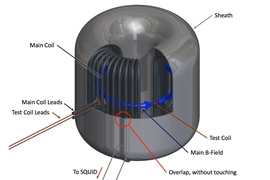MIT physicists are proposing a new experiment to detect a dark matter particle called the axion. If successful, the effort could crack one of the most perplexing unsolved mysteries in particle physics, as well as finally yield a glimpse of dark matter.
Axions are hypothetical elementary particles that are thought to be among the lightest particles in the universe — about one-quintillionth the size of a proton. These ultralight particles are virtually invisible, yet if they exist, axions and other yet-unobserved particles may make up 80 percent of the material in the universe, in the form of dark matter.
In a paper published online in Physical Review Letters, the MIT team proposes an experiment to detect axions by simulating an extreme astrophysical phenomenon known as a magnetar — a type of neutron star that generates an immensely powerful magnetic field. The physicists reasoned that in the presence of an axion such a huge magnetic field should waver ever so slightly, producing a second, vastly smaller magnetic field as a signature of the axion itself.
The team consists of MIT associate professor of physics and researcher at the Laboratory for Nuclear Science Jesse Thaler, MIT Pappalardo Fellow Benjamin Safdi, and Yonatan Kahn PhD ’15, now a postdoc at Princeton University. Together, they designed an experiment to recreate the physics of a magnetar in a controlled laboratory environment, using technology borrowed from magnetic resonance imaging (MRI).
The core of the experiment, which they’ve named ABRACADABRA (A Broadband/Resonant Approach to Cosmic Axion Detection with an Amplifying B-field Ring Apparatus), consists of a series of magnetic coils, wound in the shape of a toroid, or donut, which is then encased in a layer of superconducting metal and kept in a refrigerator at temperatures just above absolute zero, to minimize external noise. The scientists plan to use a highly sensitive magnetometer, placed inside the donut hole, to detect any signs of axions’ influence.
“Axions are very strange, counterintuitive particles,” Thaler says. “They’re extremely light, with feeble interactions, and yet this particle may dominate the matter budget of the universe and be five times more abundant by mass than ordinary matter. So we really had to think hard on whether these particles are in principle detectable using current technology. It’s extremely daunting.”
A “tantalizing” particle
If they are detected, axions may also explain an outstanding dilemma in particle physics, known as the Strong CP (charge parity) problem: Since the 1970s, scientists have grown increasingly puzzled over what Safdi describes as “the indifference of neutrons to electric fields.” Neutrons are elementary particles that are found in the nucleus of almost every atom in matter, and they do not carry a net charge.
“We don’t expect neutrons to accelerate in the presence of an electric field because they don’t carry electric charge, but you might expect them to rotate,” Safdi says. “That’s because we expect them to have an electric dipole moment, where you can think of a neutron having a plus charge on one side and a minus charge on the other. But from our current understanding, this rotation effect does not exist, whereas theory says it should.”
Scientists have hypothesized that this bizarre effect may be explained by the axion, which would somehow remove a neutron’s electric dipole moment. If so, the axion would modify electric and magnetic phenomena in a way that could be detectable experimentally.
“It’s very tantalizing to say there might be a particle that serves this deep purpose, and even more so if we were to detect the presence of these particles in the form of dark matter,” Thaler says.
The hunt is on
Currently, Thaler says most axion hunting has been carried out by researchers at the University of Washington who are running the Axion Dark Matter Experiment, or ADMX. The experiment uses a resonant microwave cavity, set within a large superconducting magnet, to detect very weak conversions of axions to microwave photons. The experiment is tuned to look for axions within a specific range of around one quadrillionth the mass of a proton.
Thaler and his team realized that they could extend this range, and look for much smaller, lighter particles, on the order of one quintillionth the mass of a proton, by recreating the physics of magnetars, in the lab.
“The Strong CP problem is associated with whether a neutron’s spin responds to electric effects, and you can kind of think of a magnetar as one gigantic spin with big magnetic fields,” Thaler explains. “If axions are coming in and changing the properties of nuclear matter to resolve the Strong CP problem, maybe axions can interact with this magnetar and allow you to see it in a new way. So the subtle effects of axions should be amplified.”
The team’s prototype design is surprisingly small — “about the palm of your hand,” Safdi says. The researchers, who are theoretical physicists by training, are now working with experimentalists at MIT to build the prototype, which is designed to generate a baseline magnetic field of about 1 tesla, comparable to current MRI machines. If axions are present, that field should waver slightly, producing a very tiny oscillation at a frequency that is directly related to the axion’s mass. Using a high-precision magnetometer, Thaler hopes to pick up that frequency and ultimately use it to identify the axion’s size.
“Only recently have there been many good ideas to search for [low-frequency axions],” says Gray Rybka, an assistant professor of physics at the University of Washington and an ADMX researcher, who was not involved in the research. “The experiment proposed here builds on previous ideas and, if the authors are correct, may be the most practical experimental configuration that can explore some of the plausible lower-frequency axion regimes.”
“We have an instrument that’s sensitive to many wavelengths, and we can tickle it with an axion of one particular wavelength, and ABRACADABRA will resonate,” Thaler says. “And we will be going into uncharted territory, where we could possibly see dark matter from this prototype. That would be amazing.”
This research was supported, in part, by the U.S. Department of Energy and the Alfred P. Sloan Foundation.













